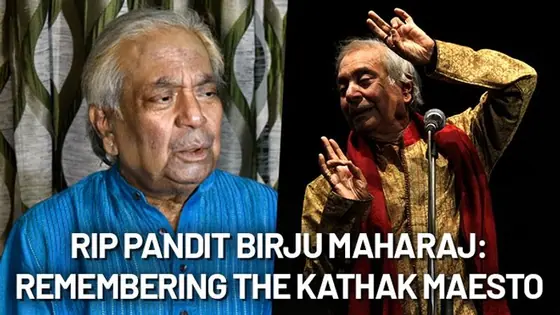
The life and times of Pandit Birju Maharaj: Remembering the Kathak legend & one of India's most-loved artistes
A doyen and torch-bearer of Kathak, Pandit Birju Maharaj passed away at his home in Delhi on Sunday after suffering a heart attack at the age of 83.
Indian classical dance arena on Sunday lost one of its most revered and loved Kathak exponents, Pandit Birju Maharaj. A doyen and torch-bearer of the dance form, Panditji, as he was fondly known, passed away at his home in Delhi after suffering a heart attack. The 83-year-old Padma Vibhushan awardee was not just one of India's best-known artistes but was also a sensitive poet and a captivating orator.

Pandit Birju Maharaj, who gave his first Kathak performance at the age of seven, will be remembered for his relentless attempt to take Kathak to a whole new level and the maestro not only made the Indian classical dance form popular in India but also in western countries. Introduced to Kathak at a very young age, Panditji went on to master the nuances of the dance form, with nimble feet movements and facial expressions that won the hearts of many. Considered an epitome of Kathak by many, here's a look at the life and times of Pandit Birju Maharaj.
Panditji was born Brij Mohan Mishra on February 4, 1937, into a household renowned for Kathak proponent Jagannath Maharaj of Lucknow Gharana. His father, Achchan Maharaj, invested a lot of his time in teaching young Birju the fundamentals of Kathak. Young Birju also accompanied his father to places where the legend displayed unmatched Kathak skills. As a result, young Birju took to learning the dance form at a very early age. His uncles, Lachhu Maharaj and Shambhu Maharaj, also inspired him and guided him in learning Kathak. At the tender age of 10, young Birju lost his father, and following the unfortunate demise, the family moved to then Bombay, where he continued to learn the subtlety of Kathak from his uncles. At the age of 13, Birju was invited to Delhi to teach at the Sangeet Bharati, which marked the start of a journey that witnessed endless growth, fame and reverence.
However, the journey was not an easy one for Birju Maharaj. In one of his interviews, Panditji spoke about his move to Delhi was not an easy one talking about how he would often find himself lost in the streets of the nation's capital until he landmarked Regal Cinema. He would first travel to Regal Cinema and then find his way back home or to the institute. Soon, Delhi became home for him and spent decades at his residence in Lutyens'.
Also read: Lesser known facts about Pandit Birju Maharaj
Pandit Birju Maharaj's journey as a teacher began at the age of 13. After a successful stint at Sangeet Bharati, he went on to teach at the famous Bharatiya Kala Kendra. Soon, he was presented with an opportunity of a lifetime. Panditji became the head of a team of teachers at the Kathak Kendra, a unit of Sangeet Natak Akademi. He served as the Head of Faculty at the Kathak Kendra for decades before he retired in 1998 at the age of 60.
However, starting his own dance school was one of Pandit Birju Maharaj's most-cherished dreams. This dream came true after his retirement when he started Kalashram. A temple for several Kathak dancers in India and the world over, students in Kalashram not just learned the classical dance form but also were offered to master in other associated disciplines like vocals, instrumental music, yoga, painting, Sanskrit, dramatics, etc. Panditji was always a firm believer that a dancer must have adequate knowledge of music for a better understanding of laya and taal. He was himself an exceptional singer with a strong grip over Thumri, Dadra, Bhajan and Ghazals. He also tried his hand at writing and was known to pen some beautiful ballet compositions during his time. Also, since a dancer must master control over the breath, Panditji advocated practising yoga to aspiring Kathak dancers.
Pandit Birju Maharaj was not only a noted Kathak dancer but also made his mark in the film industry with some outstanding dance compositions. In the movie 'Shatranj Ke Khilari', Panditji had composed two dance sequences for which he had lent his voice as well. In the 2002 movie 'Devdas', starring Madhuri Dixit, who has attained training in Kathak, Birju Maharaj had choreographed the song 'Kaahe Chhed Mohe.' He has choreographed sequences in movies like 'Dedh Ishqiya', 'Umrao Jaan', and 'Bajirao Mastani.' In 2013, Panditji made his South Indian movie debut when he choreographed the song 'Unnai Kaanatha Naan' for Kamal Haasan's 'Vishwaroopam', for which he bagged a National Award. He also bagged the Tamil Nadu State Film Award for Best Choreographer for the same movie. In 2016, he also bagged the Filmfare Award for Best Choreography for the film 'Bajirao Mastani'.
During his life span, Pandit Birju Maharaj was honoured with several accolades, including the coveted Padma Vibhushan in 1986. He is also a recipient of the Kalidas Samman by the Government of Madhya Pradesh, Sangeet Natak Akademi Award, Soviet Land Nehru Award and Sangam Kala Award, among others. In 2002, he was bestowed with the Lata Mangeshkar Puraskaar and was also conferred with honorary Doctorate degrees from Khairagarh University and Banaras Hindu University.
An ardent devotee of Lord Krishna, Pandit Birju Maharaj's mysticism, spirituality and his gift of observing the dance of nature made him a natural visionary. A firm believer of dance has a deep connection with spiritualism, Panditji also advocated the balance between one's mind and soul. All those who considered him as their guru always spoke about Panditji's humility and humble nature, where he surrendered to being a lifelong learner of Kathak.
Pandit Birju Maharaj is survived by five children – two sons and three daughters and five grandchildren. Among his five children, Deepak Maharaj, Jai Kishan Maharaj and Mamta Maharaj are prominent Kathak dancers.